Pentax K7 : A Field Review |
When I began my search for a new camera for my upcoming book project, Pentax never crossed my mind. In fact, I wasn’t even sure that Pentax was still in business. But then I received a spam email from a camera dealer I frequently purchase from, which showcased Pentax’s new K7 and all its features.
On paper, the specs looked pretty close to what I was looking for; a small, extremely durable camera that could produce high quality images. Intrigued, I visited the Pentax website and I discovered that Pentax produces a line of tiny, professional quality, modern prime lenses. I decided to give Pentax a try. Plus, I have always tried to support the underdog.
My Kit
My latest book project involves one year of photographing in Chugach State Park, Alaska. I will be hiking, skiing and climbing throughout the park. I will be carrying all my equipment and the poor camera will suffer dearly: rain, ice, snow, sub-minus temperatures and my legendary ability to kill cameras. Pentax may ultimately regret claiming the K7 as being a super durable “pro” camera. Many a “pro” camera has not returned from my adventures.
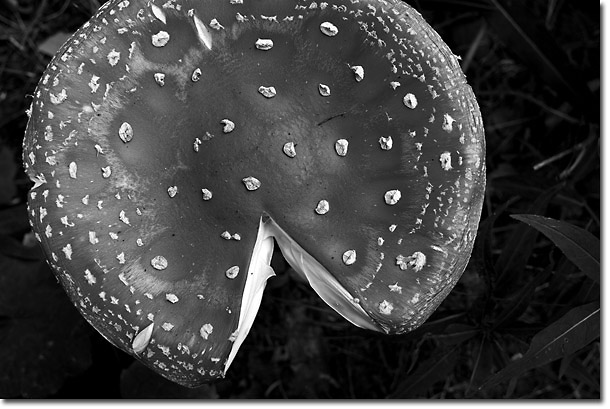
Fly Agaric Mushroom, Chugach State Park, Alaska
Pentax K7, 21mm DA Limited
I needed to keep things light and compact. so I decided to purchase the K7, two prime lenses, the 21mm DA limited and the 70mm DA limited, four batteries and a remote release. I also have my Singh Ray grads, one B+W polarizer, one B+W ND filter and my trusted Gitzo carbon tripod with a Really Right Stuff head. Everything, including my small camera bag and tripod, weigh in at 8.5 pounds. Not too bad. The entire kit, minus the tripod of course, is about the size of a NFL football.
Durability
I have had the camera for only a few weeks and while it’s not cold in Alaska yet, here are my impressions so far. At first glance, the K7 looks like a small, inexpensive SLR camera. There is nothing “pro” about its size or looks, which is just fine with me. When you pick up the tiny camera, it has more weight to it than you would expect and that is when you realize that it’s made of metal, not plastic. The build quality seems good, but I haven’t dropped it or anything so I can only go by how it “feels.”
Pentax claims the camera is weather proof, so I let it sit out in the rain while I sat in my tent reading the manual, two hours later the rain stopped and the camera worked fine. My real concern is how it performs in extreme temperatures. The K7 is the only digital camera that claims to have an operating temperature below 32 degrees F. That takes guts. Of course, most camera’s can perform far below 0 degrees F, but no other camera manufacturer has dared to claim that their camera cannot only work, but perform at its full potential below freezing, a lofty boast indeed. I can’t wait for it to get cold!
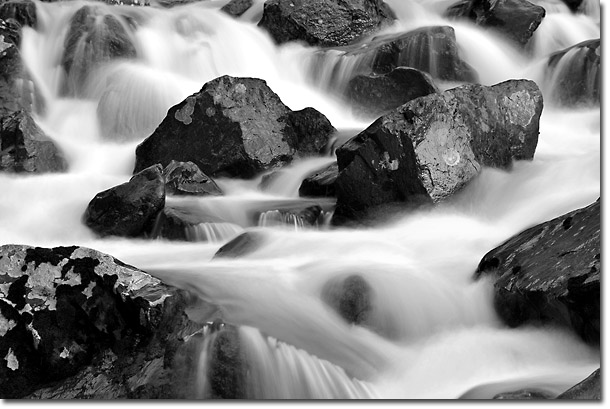
Upper South Fork of Eagle River, Chugach State Park, Alaska
Pentax K7, 70mm DA Limited
Even if the camera does work when things get cold, if the batteries die quickly, who cares? So far, I have taken 448 raw photos and the battery is still at full charge. Impressive. If the battery can perform half that good at 0 degrees F, I would be amazed.
Features
I use Aperture Priority, Spot Metering, Exposure Compensation and Mirror Lock Up on about 90% of all my images. The camera has all these settings, so I am happy. The meter seems to under expose by about ¾ a stop. I was really surprised that the K7 didn’t have a dedicated mirror up switch. Having the mirror up function hiding in the menu is unfortunate and Pentax should have known better. I have my User Mode set for mirror up, spot metering and +1 stop over exposure, providing a quick switch to the features I use most.
What about the bells and whistles? Well, they are just not needed. Most are just gimmicks, like the HDR Function. It sounds like a cool idea, but it only works with Jpegs, so it really isn’t made for professional applications. What about the video? Yes, the K7 shoots HD video and the quality is good. But Pentax really dropped the ball and didn’t take the technology any further, in fact, they landed behind Canon’s 5D Mark II and way behind Panasonic’s GH-1. I am not going to go in depth about the video function because this review is about using the K7 as a still camera. However, I will state that it appears we are not going to see any of the big SLR companies offer a serious combo-cam until the RED Scarlet appears and blows them all out of the water.The unique feature I was really bummed about is the built in Interval Timer. I use time-lapse in all of my cinematography and was looking forward to doing some time-lapse when I was out in the field. But Pentax blew it by only allowing 99 frames to be taken. That means when you play them back at say 30 frames per second, you only get three seconds of footage.
Image Quality
If a camera can’t produce publishable images, then it really doesn’t matter what features it has and how durable it is. Now, I am going to admit something no one seems to want to admit. Any of the current pro or semi-pro cameras (even most consumer models) being produced today can create double page, magazine quality images. There I said it. Now we can all quit comparing the different camera models and running those ultra technical sensors tests, that really mean nothing, and go outside and start making photographs.
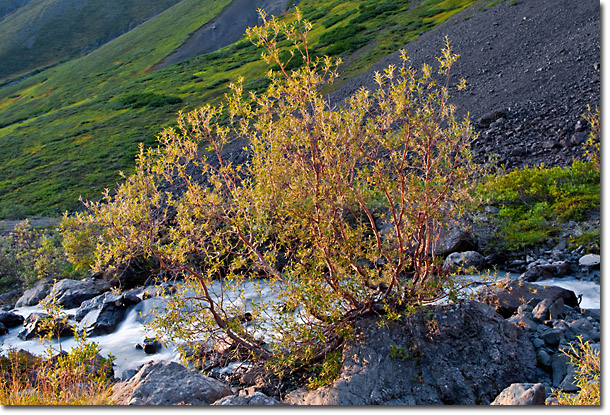
Willow, Chugach State Park, Alaska
Pentax K7, 70mm DA Limited
So, the image quality of the K7 can produce magazine, book and fine art quality images. However, each camera does have its strengths and weaknesses and a “look” that is unique to each manufacturer. So l will talk briefly about the “feel” or “quality of the quality” of the K7 images.
The K7 has 14.6 MPs crammed into an APS-C sensor. This of course, means two things: a unforgiving sensor and poor high ISO performance. The DNG Raw images produced from the K7, using the DA Limited prime lenses, are a little soft right out of the camera but sharpen up very nicely in Adobe Camera Raw. The detail is superb and the files show no signs of any aberrations. In fact, the files from the K7 are some of the most artifact free images I have ever seen. I give much of the credit to the superb DA Limited lenses. Being able to shoot in DNG is great. I wasn’t forced to upgrade to CS4 just because I bought a new camera.
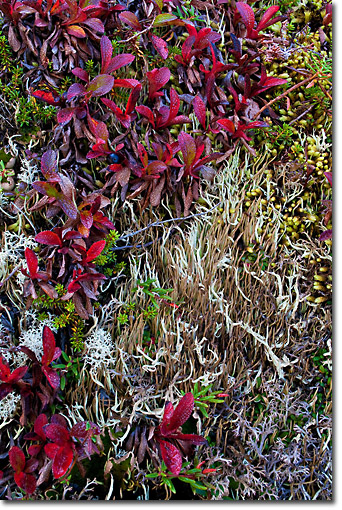
Tundra Detail, Chugach State Park, Alaska
Pentax K7, 21mm DA Limited
I rarely shoot over ISO 400. 90% of my images are shot at ISO 100. So honestly, I could care less about the camera’s ability to shoot at ISO 1,600! There is some noise present even in files shot at ISO 400, but they clean up, just like the sharpness, very nicely in ACR. If you really need high ISO performance, then you should be reading full frame camera reviews instead.
Other Notes
Because of the camera’s ultra resolution, you need to really nail the focus. I usually manual focus and found the Focus Assist, a little green light in the viewfinder, helpful in insuring that my old eyes we’re seeing correctly. However, the effectiveness of the focus assist diminishes as the EV level drops (just like the AF would), especially with the DA primes.
The camera was not auto focusing properly with the DA 21mm. But this was fixed easily with the camera’s built in Focus Adjustment. The 70mm was right on the money.
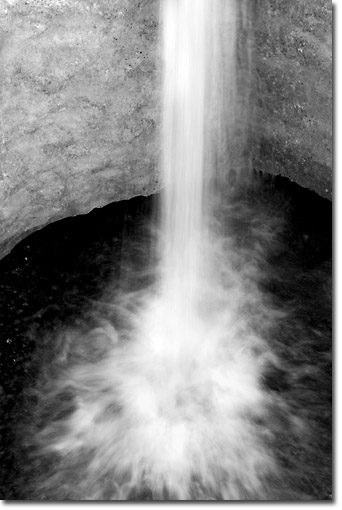
Bottom of a Moulin, Flute Glacier, Chugach State Park, Alaska
Pentax K7, 70mm DA Limited
The DA Limited primes are tiny and it is very easy to misplace their little 49mm hoods and caps. The hood for my 21mm is somewhere on the Flute Glacier. I usually purchase generic caps and hoods and paint them orange so I don’t lose them, this will be a must for these tiny, expensive parts.
Is She A Keeper?
Yes, I will use this very capable camera for my project. Its long-term durability is yet to be decided, but I am confident that it will survive. Is this camera a revolutionary tool? No. I can’t imagine anyone selling his or her Canon, Nikon or Sony gear to switch to Pentax. But if you don’t already have an investment in a system and are looking for an SLR camera for backpacking and climbing photography, than the K7 can’t be beat.
By the way, if you would like to follow along as I take the K7 through the paces for the next year, visit: www.chugachstateparkproject.wordpress.com
Comments on NPN digital nature photography articles? Send them to the editor. NPN members may also log in and leave their comments below.
For the past fifteen years, Carl Battreall has straddled the line between fine art and adventure photographer. His work has been featured in a wide variety of publications, from fine art magazine’s like Lenswork to major outdoor sports magazines like Climbing. In 2007, Carl received the Daniel Housberg Wilderness Image Award for his conservation photography work in the Alaska Range and in 2008 he was awarded a Rasmuson Artist Fellowship. Carl's website is www.photographalaska.com.